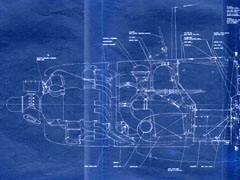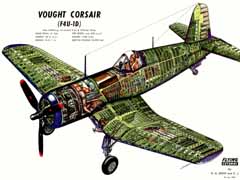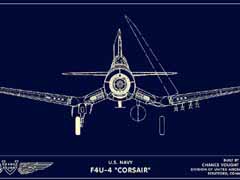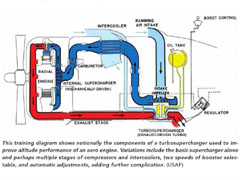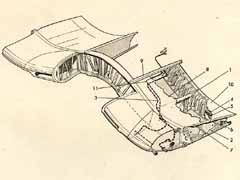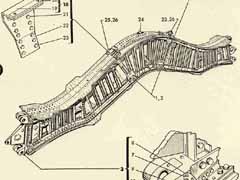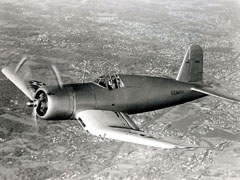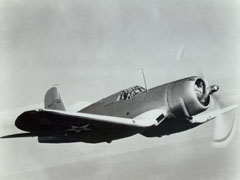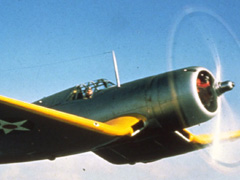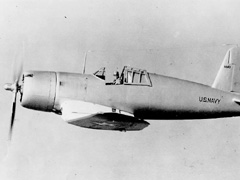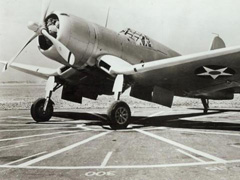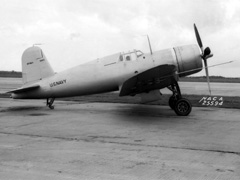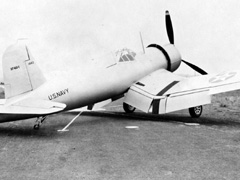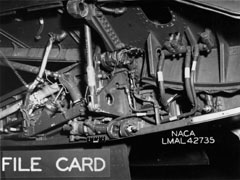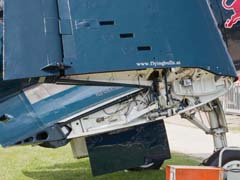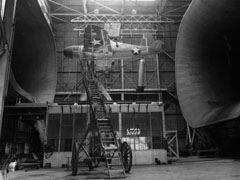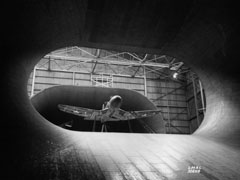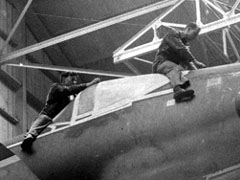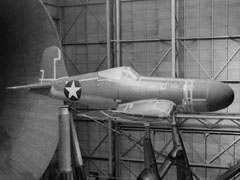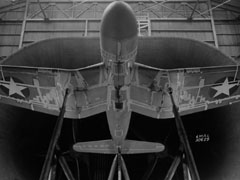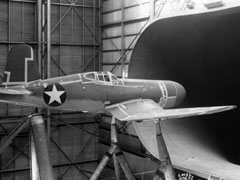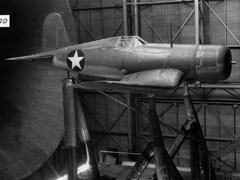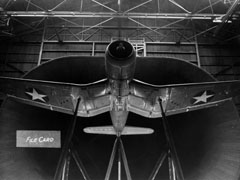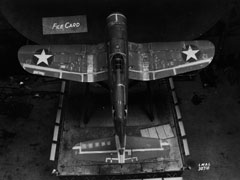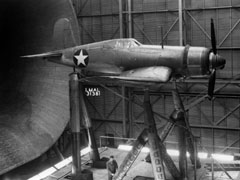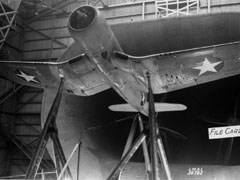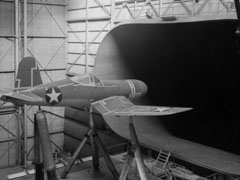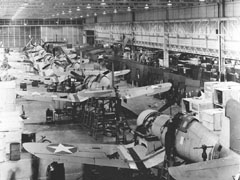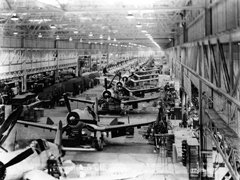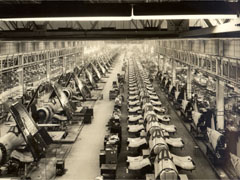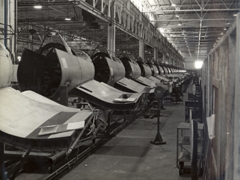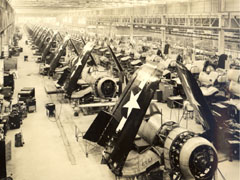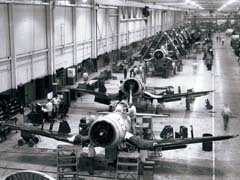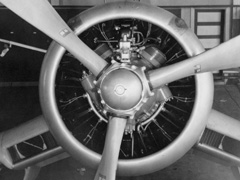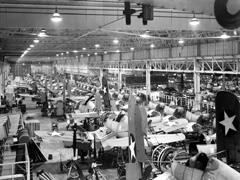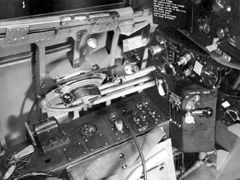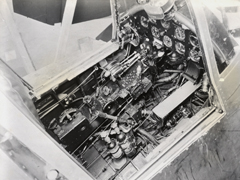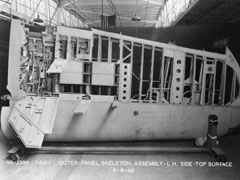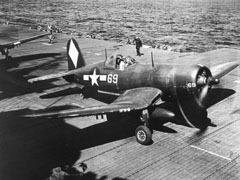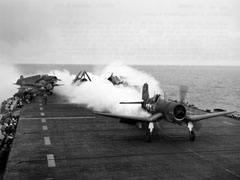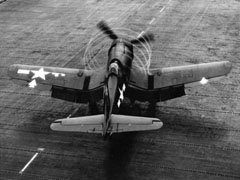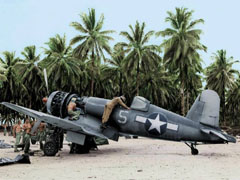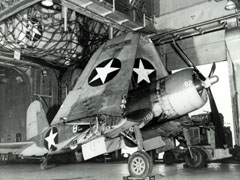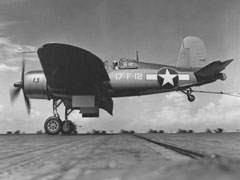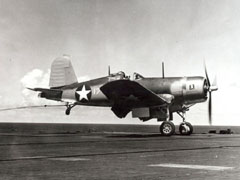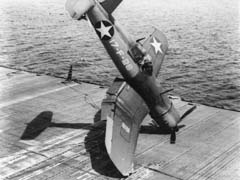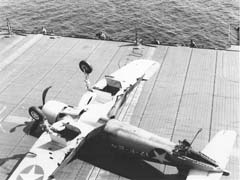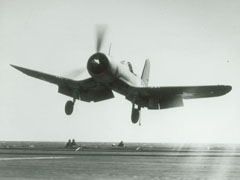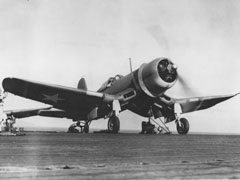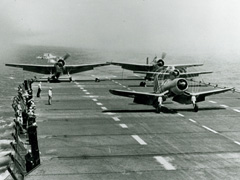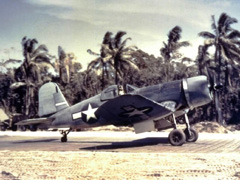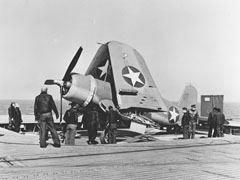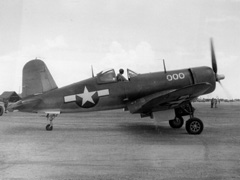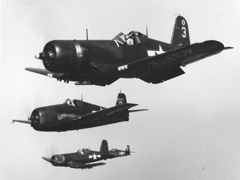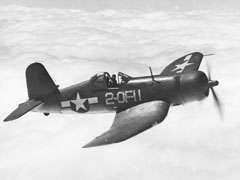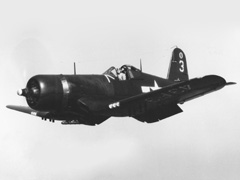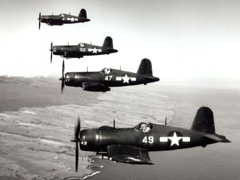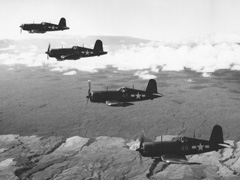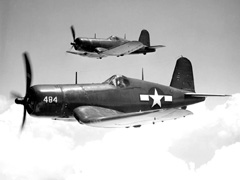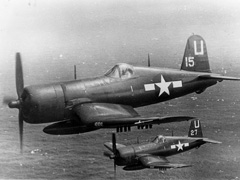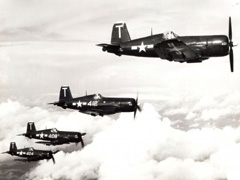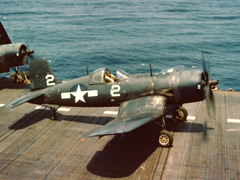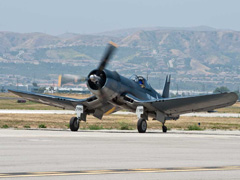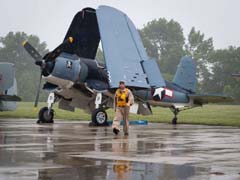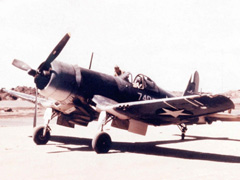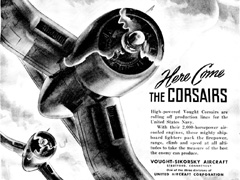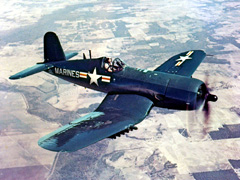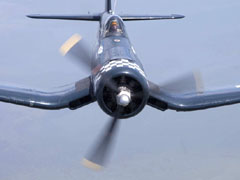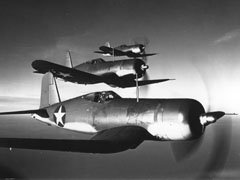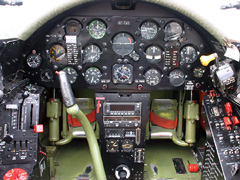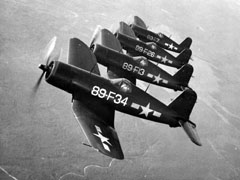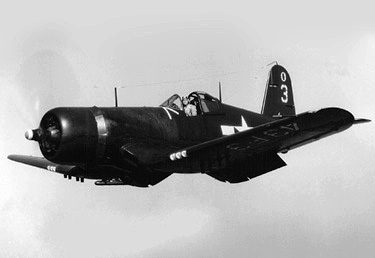 |
|
Aircraft Type |
Carrier-borne fighter |
|
Manufacturer |
Vought-Sikorsky Aircraft / Chance Vought |
|
Engine |
Radial 18-cylinder, air-cooled, 2,804 cid |
|
Horsepower |
2,100 hp (1,566 kW) at 2,800 rpm
|
|
Weight |
9,205 lb (empty)
12,420 lb
(gross) |
|
Max Speed |
446 mph (387 kn, 717 km/h) |
|
Configuration |
Single
seat (pilot) |
|
|
| |
|
The Vought-Sikorsky F4U Corsair was an
American fighter aircraft that saw service primarily in
World War II and the Korean War. Demand for the aircraft
soon overwhelmed Vought's manufacturing capability,
resulting in production by Goodyear and Brewster.
Goodyear-built Corsairs were designated FG
and Brewster-built aircraft F3A. From the
first prototype delivery to the U.S. Navy in 1940, to final
delivery in 1953 to the French, 12,571 F4U Corsairs were
manufactured by Vought, in 16 separate models, in the
longest production run of any piston-engined fighter in U.S.
history (1942–53).
The Chance-Vought F4U Corsair first flew on May 29, 1940.
The fighter was designed as a carrier-based aircraft.
However its difficult carrier landing performance rendered
the Corsair unsuitable for Navy use until the carrier
landing issues were overcome when used by the British Fleet
Air Arm. The Corsair thus came to and retained prominence in
its area of greatest deployment: land based use by the U.S.
Marines. The role of the dominant U.S. carrier based fighter
in the second part of the war was thus filled by the Grumman
F6F Hellcat, powered by the same Double Wasp engine first
flown on the Corsair's first prototype in 1940. The Corsair
served to a lesser degree in the U.S. Navy. As well as the
U.S. and British use the Corsair was also used by the Royal
New Zealand Air Force, the French Navy Aéronavale and other,
smaller, air forces until the 1960s. Some Japanese pilots
regarded the F4U Corsair as the most formidable American fighter of World
War II, and the U.S. Navy.
After the carrier landing issues had been tackled it
quickly became the most capable carrier-based fighter-bomber
of World War II. The Corsair served almost exclusively as a
fighter-bomber throughout the Korean War and during the
French colonial wars in Indochina and Algeria.
|
Company History
|
|
Over the decades, the
Vought name has traversed an interesting, yet convoluted
corporate maze. The industry dominance of its large parent
companies, have
invoked anti-trust laws more than once, and it has seen a
myriad of corporate buyouts. Vought now belongs to the
Triumph Group, an aerospace component manufacturer. It
operates as Triumph Aerostructures - Vought Aircraft
Division, making aft fuselage sections for the Boeing 787
Dreamliner. |
Chance Vought years 1917–1928
The Lewis and Vought Corporation was founded in 1917 and
was soon succeeded by the Chance Vought Corporation in 1922
when Birdseye Lewis retired. A former chief engineer of the
Wright Company, Chance M. Vought founded the company to take
advantage of the growing field of military and civilian
aviation after World War I. Operations began in Astoria, New
York and in 1919 were moved to Long Island City, New York.
Vought died from septicemia in 1930, but in that short
time period succeeded in producing a variety of fighters,
trainers, flying boats, and surveillance aircraft for the
United States Navy and the United States Army Air Service.
Vought made history in 1922 when their Vought VE-7 trainer
made the first takeoff from the deck of the USS Langley, the
first American aircraft carrier. Following this success came
the VE-11 naval fighter and the Vought O2U Corsair, the
first of the Corsair aircraft.
In 1928, the company was acquired by United Aircraft and
Transport Corporation, but stayed its own separate division
among the likes of Pratt & Whitney and Boeing.
1930s–1960
Despite the Great Depression, Vought continued to design
and manufacture aircraft at a growing pace. Soon after
Chance Vought's death in 1930, the company moved its
operations to East Hartford, Connecticut. Under the Air Mail
Act of 1934, United Aircraft and Transportation Corp. was
forced by law to divide its businesses, resulting in Boeing
Aircraft, United Airlines, and the United Aircraft Corp, of
which Vought was a part. In 1939 United Aircraft moved
Vought to Stratford, Connecticut where their Sikorsky
division was located and renamed the merged divisions
Vought-Sikorsky Aircraft.
Chief Engineer Rex Beisel began in 1938 to develop the
XF4U, recognized by its distinctive inverted gull wings.
After its first flight in 1940, thousands of F4U Corsairs
were produced for the Navy and Marines in World War II. By
the end of its production in 1952, Vought, Goodyear, and
Brewster had all produced the Corsair fighters. Vought was
reestablished as a separate division in United Aircraft in
1942.
|
 |
|
 |
Vought-Sikorsky Aircraft
Division of United
Aircraft Corporation
1939-1943
Stratford, Connecticut
|
|
Chance Vought Aircraft
Division
of United
Aircraft Corporation 1943-1954
(Move to
Dallas, Texas in 1948) |
|
|
|
Timeline
|
| 1917 |
|
Lewis and Vought Corporation is
founded by Birdseye B. Lewis and Chauncey "Chance"
Milton Vought in
Astoria, NY. |
| 1918 |
|
Lewis and Vought Corp. moved to Long Island
City, NY. |
| 1922 |
|
Lewis and Vought was reorganized as the Chance
Vought Corporation when Lewis retired. |
| 1929 |
|
Renamed Chance Vought Aircraft, the company
moved to East Hartford, Connecticut when acquired by
a newly formed holding company, United Aircraft and
Transport Corporation (UATC). Vought joined other
subsidiaries acquired by UATC that included Pratt &
Whitney engines, Hamilton Standard propellers,
Sikorsky Aircraft, and Boeing Airplane and
Transport. |
| 1930 |
|
Chance M. Vought dies from septicemia at age 40.
F. B. Rentschler (Chairman of UATC) is elected
President of the subsidiary. |
| 1934 |
|
Under the Air Mail Act of 1934, and new
anti-trust laws, UATC is forced to dissolve on
September 26, 1934. Chance Vought Aircraft becomes
part of newly formed United Aircraft Manufacturing
Company (UAMC). |
| 1935 |
|
By June, all but Boeing formed the UAMC, part of
the new United Aircraft Corporation (UAC). UAMC
subsidiaries included Chance Vought Corp., Hamilton
Standard Propeller Co., Sikorsky Aircraft Corp., The
Pratt & Whitney Aircraft Co., United Aircraft
Exports Corp., and The United Airports of
Connecticut, Incorporated. UATC's airline interests
went on to become United Air Lines (UAL). A separate
United Aircraft Exports Corporation (UAEC) was
organized. All in turn were subsidiaries of the
United Aircraft Corporation (UAC). |
| 1937 |
|
R. W. Clark became general manager of Chance
Vought Aircraft and Sikorsky Aircraft divisions. |
| 1939 |
|
Vought and Sikorsky merged and becomes Vought-Sikorsky Aircraft, and became a single
division under UAC. Vought was moved from East
Hartford to Stratford,
CT, where the larger Sikorsky plant was located. |
| 1940 |
|
C. J. McCarthy was appointed general manager of
Vought-Sikorsky Division. The F4U
Corsair first flew on May 29, 1940. |
| 1943 |
|
Chance Vought and Sikorsky
divisions were reconstituted, with Vought assuming
its former title, and Sikorsky moving to a new site
in Bridgeport to concentrate on helicopter
development and production. |
| 1948 |
|
Chance Vought Aircraft moves to Dallas, Texas.
Frederick O. Detweiler is named general manager. |
| 1954 |
|
Vought separates from the UAC and becomes an
independent corporation again on July 1, 1954.
Detweiler becomes president of Chance Vought
Aircraft, Incorporated. The company was spun off
(first as a subsidiary in January 1954) owing to
concerns that it might gain unfair advantage from
Pratt & Whitney's dealings with other manufacturers. |
| 1960 |
|
The company became Chance Vought Corporation on
December 31, 1960, with its aircraft section called
the Aeronautics Division. |
| 1961 |
|
Vought merged with Ling-Temco Electronics
and formed Ling-Temco Electronics, Inc., following Vought's failed antitrust suit against
Ling. Paul Thayer, a former test pilot, replaced F. O. Detweiler as
president of Vought. |
| 1963 |
|
The "Chance Vought" name survived until a
reorganization of Ling-Temco-Vought (LTV) on October
20, 1963. |
| 1965 |
|
Vought Aeronautics formed as a division of LTV
Aerospace Corporation, a subsidiary of LTV
Incorporated. Vought operations
comprised
the bulk of the division. |
| 1969 |
|
The company name was changed from Vought
Aeronautics Division to Vought Aeronautics
Company, a division of LTV Aerospace
Corporation. |
| 1971 |
|
Ling-Temco-Vought was renamed LTV Corporation.
It had three divisions, LTV Aerosystems,
LTV Electrosystems, and LTV Ling-Altec. By this
time, LTV Aerosystems was comprised of Vought Aeronautics Company, a few other
units, and Vought Helicopters, Inc. |
| 1972 |
|
The Vought units were reorganized as the Vought
Systems Division of LTV Aerospace. The aircraft
producing unit was named the Vought
Aeronautics Division. |
| 1973 |
|
Vought Aeronautics Davison name was changed to
Vought Systems Division to reflect
its desire to diversify. |
| 1976 |
|
All of LTV Aerospace renamed
Vought Corporation on January 1,
1976. The parent company LTV Corporation had become
a $4 billion diversified conglomerate. |
| 1983 |
|
Vought Corporation was again split along
aeronautic and missile lines under LTV
Aerospace and Defense Company. |
| 1992 |
|
Vought and LTV split. Vought was purchased by
Northrop and Carlyle Group, each
owning about 50%. |
| 1994 |
|
Northrop Grumman, the successor
to Northrop and Grumman, bought out Carlyle Group's
share of Vought for $130 million. |
| 2000 |
|
Carlyle Group purchased the
entire company from Northrop Grumman and established
Vought Aircraft Industries, Inc. Its function was primarily as an aero-structures
subcontractor with heavy involvement in the Boeing
747 and 787 as wells as supplying parts for various
military aircraft. |
| 2003 |
|
The Aerostructures Corp., owned
by the Carlyle Group and based in Nashville, merged
with Vought. |
| 2009 |
|
Boeing acquired the Vought
Aircraft Industries manufacturing facility, in North
Charleston, SC, for $580 million. |
| 2010 |
|
The Carlyle Group sold Vought to the Triumph
Group, an aerospace component manufacturer. The
Vought acquisitions now operate as Triumph
Aerostructures - Vought Aircraft Division. |
|
|
|
|
|
|
|
Specifications F4U-4 Corsair
Bureau of Aeronautics Navy Department (Mar 1946)
| General Characteristics (Loading condition 1 combat) |
| Crew: |
|
One pilot |
| Length: |
|
33 ft 8.25 in (10.2 m) |
| Wingspan: |
|
40 ft 11.75 in (12.5 m) |
| WS Folded: |
|
17 ft 0.5 in (5.2 m) |
| Height 3-Pt.: |
|
14 ft 9.5 in (4.5 m) |
| Height Folded: |
|
16 ft 4.5 in (5.0 m) |
| Length Level: |
|
|
| Wing area: |
|
314 ft² (29.2 m²) |
| Empty weight: |
|
9,205 lb (4,174 kg) |
| Gross weight: |
|
12,420 lb (5,633 kg) |
| Powerplant: |
|
1 × Pratt Whitney R-2800-18W radial engine, 2,100 hp (1,566 kW) |
| Propeller: |
|
4-blade Hamilton Standard, 13 ft 2 in (4 m) |
| |
|
|
| Performance |
| Top speed: |
|
446 mph (387 kn, 717 km/h) |
| Stall speed (GW) |
|
89.4 mph
(77 kn, 143 km/h) |
| Range: |
|
897 mi (602 nmi (1,115 km)) |
| Rate of climb: |
|
3,870 ft/min (19.7 m/s) |
| Service ceiling: |
|
41,500 ft (12,649 m) |
| Time to altitude: |
|
2.9 min to 10,000 ft (3,048 m) |
| |
|
|
| Armament |
| Guns: |
|
6 × 0.50 in (12.7 mm) AN/M2 Browning machine guns, 400 rounds per gun, or4 × 0.79 in (20 mm) M2 cannon |
| Rockets: |
|
8 × 5 in (12.7 cm) high velocity aircraft rockets and/or |
| Bombs: |
|
4,000 pounds (1,800 kg) |
|
| |
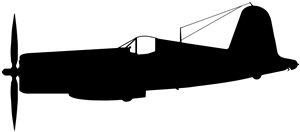 |
| Aircraft silhouette |
| |
| |
 |
Vought-Sikorsky Aircraft
United
Aircraft Corporation
Stratford, Connecticut
1939-1943 |
| |
|
|
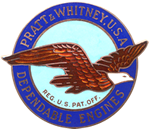 |
|
|
| |
| |
|
Engine Specifications
Pratt & Whitney R-2800-18W Double Wasp "C"
Series
| General specs |
|
|
| Type: |
|
18-cylinder air-cooled twin-row supercharged radial piston engine with water injection |
| Bore: |
|
5.750 in (146.05 mm) |
| Stroke: |
|
6.000 in (152.4 mm) |
| Displacement: |
|
2,804 in³ (46 L) |
| Diameter: |
|
52.8 in (1,342 mm) |
| Dry weight: |
|
2,360 lb (1,073 kg) |
| |
|
|
| Components |
|
|
| Valvetrain: |
|
Two overhead valves per cylinder |
| Supercharger: |
|
Two-stage, two-speed, centrifugal type supercharger |
| Reduction gear: |
|
2:1 |
| Fuel system: |
|
One Bendix-Stromberg PT-13G2-10, updraft, pressure carburetor, 3-venturi |
| Fuel type: |
|
100/130 octane gasoline |
| Cooling system: |
|
Air-cooled |
| |
|
|
| Performance |
|
|
| Power output: |
|
2,100 hp (1,566 kW) at 2,800 rpm for takeoff, up to 2,380 hp (1,775 kW) WEP |
| Specific power: |
|
0.75 hp/in³ (34.0 kW/L) |
| Compression ratio: |
|
6.75:1 |
| Power/weight ratio: |
|
0.89 hp/lb (1.46 kW/kg) |
| Engine was
the first series production variant of the
"C" Series, which was a complete
redesign of the R-2800. Some of the main
changes were forged, rather than cast
cylinders, allowing an increased
compression ratio (from 6.65:1 to
6.75:1), a redesigned crankshaft, a
single piece, rather than split
crankcase center section, and a two
section nose casing, incorporating
hydraulically operated torque-monitoring
equipment and an automatic, vacuum
operated spark-advance unit. The
supercharger used fluid coupling for the
second stage. Updraft Bendix-Stromberg
PT-13G2-10 carburetor. Production =
3,257 (P&W). |
|
|
Pratt & Whitney |
|
R-2800-18W "Double Wasp" |
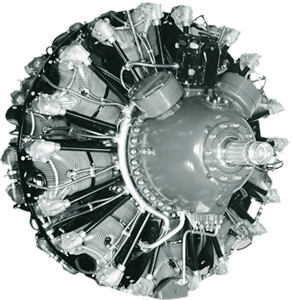 |
|
1939-1960 |
|
The 18-cylinder twin-row air-cooled
radial piston engine was 2,804 cubic
inches, supercharged, and water
injected. Production of the (P&W) R-2800
"C" Series totaled 3,257. |
|
|
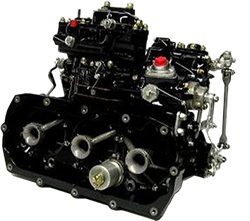
|
|
Bendix-Stromberg
PT-13G1 |
|
Pressure (injection),
3-venturi carburetor |
|
|
| |
|
|
Photos
|
F4U Corsair Design
|
|
|
Corsair XF4U-1 Prototype
|
|
|
| |
The NACA Full-Scale Wind Tunnel
|
National Advisory Committee for Aeronautics
Langley Memorial Aeronautical Laboratory
in Hampton, Virginia |
| In 1931, work was completed on what was then the world's
largest wind tunnel with a 30-ft by 60-ft test section, known as the Langley
Full Scale Tunnel. Designed by Langley staff, the tunnel could study entire
full-sized aircraft of the time and was instrumental in doing drag clean-up
studies for nearly every U.S. Fighter aircraft design in the World War II era.
The Full Scale Tunnel went on to test the Mercury space capsule, the lunar
lander test vehicle, F-16, concepts for super sonic transports, and the space
shuttle. This tunnel was also designated a National Historic Landmark, but has
since been declared obsolete and demolished. |
|
Drawings of Full-Scale Wind Tunnel - Building Number 643
|
|
NASA-Langley Research Center Recording Project. Historic
American Engineering Record. National Park Service. U.S.
Dept. of the Interior. (1995-96). |
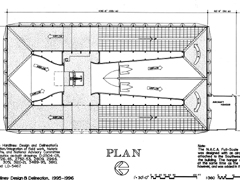 |
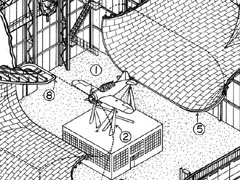 |
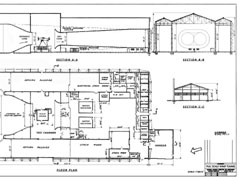 |
|
Site Plan and Building Plan |
Cutaway Isometric Detail |
Sections and Floor Plan |
|
Photos of F4U "Corsair" in
Full-Scale Tunnel 1942-43
|
|
|
Vought-Sikorsky Aircraft
Final Assembly Line in Stratford, Connecticut |
|
|
U.S. Navy Operational Training and Combat Use
|
|
|
Other Images
|
|
|
|
|
|
References
|
|
1. |
Celtic Cowboy Company.
(2013). Aeroplanes Vought.
Retrieved from http://celticowboy.com/index.htm |
|
2. |
Triumph Aerostructures
- Vought Aircraft Division. (2014). Vought
Aircraft Industries, Inc. History. Retrieved
from
http://www.fundinguniverse.com/company-histories/vought-aircraft-industries-inc-history/ |
|
3. |
U.S. Centennial of
Flight Commission. (2013). Vought Aircraft.
Retrieved from http://www.centennialofflight.net/essay/Aerospace/Vought/Aero23.htm |
|
| Photos |
|
4. |
Library of Congress. (2015). Prints &
Photographs Online Catalog. Retrieved from
http://www.loc.gov/pictures/ |
|
5. |
NASA Cultural Resources. (2011).
Test 142 - Vought-Sikorsky F4U-1.
Retrieved from
http://crgis.ndc.nasa.gov/historic/643_Test_142_-_Vought-Sikorsky_F4U-1 |
|
6. |
U.S. Centennial of
Flight Commission. (2013). Vought Aircraft.
Retrieved from http://www.centennialofflight.net/essay/Aerospace/Vought/Aero23.htm |
|
|
|







